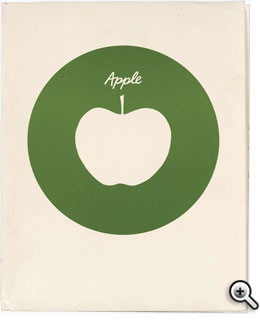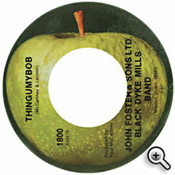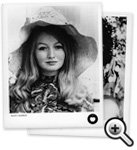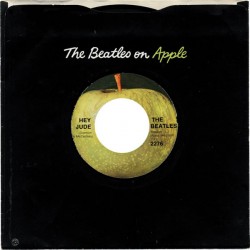Apple’s American Debut: The Original 1968 Press Kit
 On August 22, 1968, Apple Records’ Los Angeles office sent press kits to radio station program directors across the United States. The kits were packaged in white envelopes with an Apple logo in the upper left corner serving as the return address. The logo was a solid green circle with a white apple in the center with the word “Apple” in white script above the stem. The post mark indicated that the package cost a then hefty eighty cents to air mail. The lucky recipients of these envelopes would be among the first people in America to see and hear what the Beatles new Apple venture was all about.
On August 22, 1968, Apple Records’ Los Angeles office sent press kits to radio station program directors across the United States. The kits were packaged in white envelopes with an Apple logo in the upper left corner serving as the return address. The logo was a solid green circle with a white apple in the center with the word “Apple” in white script above the stem. The post mark indicated that the package cost a then hefty eighty cents to air mail. The lucky recipients of these envelopes would be among the first people in America to see and hear what the Beatles new Apple venture was all about.
Those individuals following the group already knew that John, Paul, George and Ringo had formed a new corporation named Apple Corps. Ltd. The initial U.S. promotion of Apple had been handled earlier in the year by John and Paul, who flew to New York on Saturday, May 11, 1968, for a series of events designed to spread the word. From the very start it was obvious that Apple would be different — a blend of the Beatles individualism and creativity combined with the corporate world. There was also an attitude of doing things on a whim without considering the costs of frivolous behavior. John and Paul’s first Apple business meeting in the States set the tone. It was held on a Chinese junk sailing around New York harbor and the Statute of Liberty.
On Monday, May 13, John and Paul went public, giving interviews at the St. Regis Hotel. The next day they held a press conference at the American Hotel. On Tuesday night, John and Paul appeared as guests on The Tonight Show, which was hosted that evening by former baseball great Joe Garagiola subbing for Johnny Carson. Mission accomplished, they flew back to London the following evening.
Readers of the May 25, 1968, issue of Billboard encountered an article titled “Hungry Beatles Form Apple in Bid for Slice of Trades’ Pie.” Billboard reported that the first project for Apple’s music division would be a soundtrack album for the film Wonderwall, featuring a score and arrangements by George Harrison. The article indicated that the Beatles would produce records and write songs for Apple, but would not record for Apple as the group was under contract to EMI in England and Capitol in the U.S.
More details became available a week later in a Billboard story titled “Beatles’ Apple Firm Picking U.S. ‘Core’ of Staffers, Artist Roster.” The article touted Apple’s grandiose plans. The company would have offices in Los Angeles and New York. Apple was going to develop a roster with key American artists and had just signed the Modern Jazz Quartet, who had previously been on Atlantic Records. The Beatles would actively produce new artist sessions and devote much of their time to the company. Paul McCartney had recorded Apple’s first discovery, Mary Hopkins, a sixteen year old Scottish vocalist. [Her last name was actually Hopkin and she was from Wales.] Ron Kass, director of Apple Records, indicated that a number of British artists who had developed clannish friendships with the Beatles had indicated a willingness to join Apple upon expiration of their present recording contracts with other labels. High of the list of potential artists was the Rolling Stones, who for months had been reported as entering a musical venture with the Beatles.
The article further stated Apple’s Savile Row headquarters in London would house an elaborate recording studio, complete with a computer and a control board with 72 channels, designed by Greek engineer Alexis Mardas. [In 1968, 16 channels was considered state-of-the-art. When the Beatles attempted to use the studio built by “Magic Alex” during the Get Back/Let It Be project, they discovered Mardas didn’t have a clue and were forced to bring in remote equipment from EMI.] Billboard reported that Apple was discussing U.S. manufacturing and distribution rights with five companies and hoped to reach a decision during June.
The June 29 Billboard announced that Apple Records had entered into an agreement with Capitol Records to manufacture and distribute Apple product in the United States and Canada. The August 17th issue of the magazine stated that the Beatles Apple Records project would get rolling on August 25 with the release through Capitol Records of five discs. The Initial releases would be the Wonderwall soundtrack and four singles, including a new Beatles disc featuring “two new songs written by them, ‘Revolution’ and ‘Hey Judge.’” [The latter song was really titled Hey Jude. The release of George Harrison’s Wonderwall album was pushed back to the end of the year.] The other releases would be records by Jackie Lomax, Mary Hopkins and the Black Dyke Mills Band, a traditional British brass band. It was further reported that the Beatles were at work on a new album of their own for a scheduled fall release.For those disc jockeys who had been monitoring Apple’s progress by reading trade magazines, the arrival of the classy looking white envelope with the Apple logo was truly a magic moment. Upon ripping open the envelope, the recipient encountered a glossy cream colored folder with a large Apple logo on its front side. Inside was a treasure of sound, visuals and text.
In contrast to the white envelope and folder were four distinguished-looking black center cut record sleeves. One proclaimed “The Beatles on Apple” in an attractive script font. The group’s name was in white and Apple in green. The other three sleeves merely said “Apple” in the same eye-catching green script letters. Peeking out of the center of each sleeve was a record label covered with a Granny Smith green apple.
The sleeves were not the only thing different about the singles. While most records had the same label design on both sides, these discs had a full green apple on one side and a sliced apple was its exposed white innards on the other side. The singles also had something new to most Americans — a slip guard consisting of 360 interlocking serations surrounding the label. Although the tiny grooves appeared to be an innovation of Apple, several British labels had been pressing discs with slip guards for years. By coincidence, Capitol had re-tooled its pressing plants for slip guard singles at the beginning of the month, so the Apple singles were among the first Capitol manufactured titles to take on the new look.
For program directors, the most important part of the package was the first new Beatles single in over five months: Hey Jude b/w Revolution. The quality of both sides of the single assured that listeners would stay put when the songs were aired. Disc jockeys were delighted to see that the running time for Hey Jude was an incredible 7:11. At the time the 45 was released in 1968, singles normally contained songs running between two and three minutes long. This record would truly be a DJ’s best friend when nature called or a groupie dropped by the station.
Because the Beatles were under contract to Capitol, their new record was assigned a Capitol catalog number, 2276, even though it was pressed with Apple labels and packaged in an Apple sleeve. There are at least ten different label variations of the Hey Jude single on Apple. The first pressings of the record do not have “Produced by: George Martin” or “Recorded in England” on their labels. The East Coast version has a master number (45-X-46434 for Hey Jude and 45-X-46435 for Revolution) below the record number (2276), whereas the West Coast first issue does not. The West Coast records were pressed by Capitol’s Los Angeles factory and have a machine stamped “*” symbol in the trail off areas. This LA first pressing was the version of the single included in the press kit. It was packaged inside a tab cut “The Beatles on Apple” sleeve.
 The other three singles included in the press kit were also pressed by Capitol in LA and packaged in tab cut sleeves. Unlike the Beatles disc, they have Apple catalog numbers, beginning with 1800. The first of these was Thingumybob b/w Yellow Submarine by the John Foster & Sons Ltd. Black Dyke Mills Band. The text on both sides of the label is printed vertically. Thingumybob is credited to “McCartney & Lennon.” Both sides of the disc have a Paul McCartney production credit. Paul also produced Apple 1801, Mary Hopkin’s Those Were The Days b/w Turn, Turn, Turn. All label information on this 45 appears horizontally. Apple 1802 paired Sour Milk Sea and The Eagle Laughs At You by Jackie Lomax. The record was produced by George Harrison, who is given production credit on the label. George is mistakenly listed as the writer of both songs. Although he wrote Sour Milk Sea, the B side was penned by Lomax.
The other three singles included in the press kit were also pressed by Capitol in LA and packaged in tab cut sleeves. Unlike the Beatles disc, they have Apple catalog numbers, beginning with 1800. The first of these was Thingumybob b/w Yellow Submarine by the John Foster & Sons Ltd. Black Dyke Mills Band. The text on both sides of the label is printed vertically. Thingumybob is credited to “McCartney & Lennon.” Both sides of the disc have a Paul McCartney production credit. Paul also produced Apple 1801, Mary Hopkin’s Those Were The Days b/w Turn, Turn, Turn. All label information on this 45 appears horizontally. Apple 1802 paired Sour Milk Sea and The Eagle Laughs At You by Jackie Lomax. The record was produced by George Harrison, who is given production credit on the label. George is mistakenly listed as the writer of both songs. Although he wrote Sour Milk Sea, the B side was penned by Lomax.
 The press kit also included two 8″ x 10″ black and white glossies of each of the artists featured on the records. The Beatles are represented by their cartoon images from the Yellow Submarine film. Paul and his sheep dog Martha are pictured with the Black Dyke Mills Band in the brass band’s horizontal publicity still. Jackie Lomax and the lovely looking Mary Hopkin are each featured in vertical pictures. All four glossies have the artist’s name printed below the picture towards the left side and the Apple logo in lower right corner.
The press kit also included two 8″ x 10″ black and white glossies of each of the artists featured on the records. The Beatles are represented by their cartoon images from the Yellow Submarine film. Paul and his sheep dog Martha are pictured with the Black Dyke Mills Band in the brass band’s horizontal publicity still. Jackie Lomax and the lovely looking Mary Hopkin are each featured in vertical pictures. All four glossies have the artist’s name printed below the picture towards the left side and the Apple logo in lower right corner.
Recipients of the press kit learned about each artist through separate 8 1/2″ x 11″ information sheets and 5 1/2″ x 8 1/2″ booklets. The text of the information sheets is credited to Apple press agent Derek Taylor. Although no credit is given in the booklets, the writing is appears to be the work of Derek Taylor as well.
The information sheet on the Beatles reads in part:
“It is the Beatles again, doing it again, doing our minds in again with the magical mystic Beatle mastery of their medium. They are the message, are the medium. They have written and produced two sides for this new single which you know, you know beyond the thinnest wisp of a shadow of a doubt, will engage the most profound admiration from the public, from the industry, from those in other groups, who strive to match the Beatles achievements. ‘Hey Jude’ is lead sung by Paul McCartney and it is a long lovely loving love-song offering hope (‘Hey Jude, don’t be afraid… take a sad song and make it better…’) and beauty in the words and extraordinary melodic subtleties in the music. ‘Hey Jude’ is the longest song ever recorded by the Beatles (seven minutes and five seconds), and I would say it was the best if it weren’t for all those others that have gone before. I would say it was the best if, also, it were not that ‘Revolution’ — main voice John — were not so breathtaking vital and insistent. This is the new Beatle peace — with strength message, with the voices forced out of the grooves by a backing as new for Capitol now as Strawberry Fields was for then. A theme for today, ‘Revolution,’ written by revolutionary visionaries. The Beatles are without peer. Their music is magnificent. It can be said again and again as they sing and sing it again.”
The booklet on the Beatles is full of optimism and tells a story of the Beatles quite different from the feuding that was actually going on during the recording of the group’s first Apple album:
“The Beatles are in good health, of sound heart and willing spirit, and by the Fall the new evidence of their continuing supremacy will be spinning on the world’s turntables around the symbol of their own shimmering green Apple label.”
“At this moment they are deeply involved in the twin responsibilities of recording the album-successor to the profoundly respected Sergeant Pepper’s Lonely Hearts Club Band and of administering the Happy Apple complex of companies in London.”
“John, Paul, George and Ringo, firmly united one for all and all for one as the Beatles, growing up and outwards, phasing their expansion so as to keep a hold on which might otherwise consume their precious careers and confuse the thread of their energy sources are confident and cheerful and the human condition will be thrilled by the coming results of their willing and enduring Beatle-bondage. Unhampered by the pressures of world stardom, entranced by their opportunities, simulated by the blossoming of Apple, they will give all of us new wonders to soothe our pain.”
“The end for now, but there is no end.”
While comments about “Happy Apple” and “willing and enduring Beatle-bondage” proved false, the statements about the brilliance of the Beatles new single were on target. Hey Jude quickly topped the charts and remained at the number one spot on the Billboard Hot 100 for nine straight weeks during its 19 week run. Revolution charted separately for 11 weeks and peaked at number 12. The Beatles first Apple single sold over three million units in its first two months of release.
The information sheet on the Black Dyke Mills Brass Band urges readers (including radio program directors) to “come on and hear about the best band in the land.” The opening text was a play on the lyrics from the tune Alexander’s Rag Time Band (“Come on and hear the best band in the land”). The accompanying booklet is titled “The Black Dyke Mills Band and a Beatle.” The reader learns that the band is 113 years old and is sponsored by John Foster and Son Ltd. of the Woollen Mills in the village of Queensbury, Yorkshire near Bradford. The band, which has 27 members plus a percussion section, won The National Champion Band of Great Britain award in 1967 for the seventh time since 1945. The sheet tells the following story:
“When Paul McCartney was faced with the challenge of producing his theme song for the London TV show ‘Thingumybob’ he decided to forget studio musicians, and the sophistication of formal studios and took himself up the trunk road which splits England from top to bottom. Up from exciting London to industrial Bradford in the north where, in an ancient city, he recorded The Black Dyke Mills Band in their home town. The results are strong and amazingly contemporary for within the song there are those strange, unique touches of the Beatle-flair. The ‘B’ side is ‘Yellow Submarine,’ one of the great youth marching songs of all time played as a march as it is begged to be played. Be played by them. March to them yourselves across the living room, be young again, and brave.”
Although the single was interesting and well produced, most program directors were not brave enough to play the single on their stations. It failed to chart and is highly collectible.
The booklet on Mary Hopkin tells the tale of how super model Twiggy saw the young Welsh folk singer on the British TV talent show Opportunity Knocks and was so impressed that she told Paul McCartney of her talent. Paul signed her to be part of the launching of his dream organization, Apple. The information sheet boldly predicted that “Mary Hopkin will be #1 in the charts with Those Were The Days.” According to Derek Taylor:
“The record is produced by Paul McCartney who is English, sung by Mary Hopkin who is Welsh, written by Gene Raskin who is American. It is for all ages, all tastes, all creeds, sensibilities, for anyone with the capacity to be stirred by music and is there anyone who has not this capacity? It is a long song: it builds, grips, embraces. It will be whistled, hummed, sung, translated, exploited, adapted all over the world. It will be one of the hits of the year.”
All of the above proved true except for the prediction that the song would be number one. Although Those Were The Days was number one in England, it had to settle for the second spot in the United States, where it could not get past Hey Jude.
Although the booklet on Jackie Lomax tells more of his background than most people would care to know, the information sheet gets straight to the point: “Jackie Lomax is from Liverpool and it shows.” Derek Taylor informs the reader that:
“George Harrison produced and wrote for this first Lomax solo effort on the fresh, new just-ripening APPLE label. It is called ‘Sour Milk Sea’ — the sea we all find ourselves in from time to time. ‘Get out of that Sour Milk Sea, you don’t belong there. Come back to where you should be……’ A few words of Beatle-warning, Lomax delivered. The backing of the record is astounding — listen to the guitar solo and know that Britain can still play rock’n’roll.”
Although the information sheet justifiably raves about the Lomax single, it tells the reader little about the song’s history and recording. Sour Milk Sea was written by Harrison during the Beatles stay with the Maharishi in India in March of 1968. The Beatles recorded a demo of the song in May of 1968 at Kinfauns, George Harrison’s bungalow in Esher, Surrey. The song was one of 23 tunes recorded in demo form for consideration for the upcoming Beatles album. For reasons unknown, George decided against recording it for the Beatles LP. Instead, he gave it to Lomax as his first Apple single. The song was recorded in late June with a line up featuring the Threetles. Lomax sings lead and plays rhythm guitar along with Harrison on rhythm guitar, Paul McCartney on bass, Ringo on drums, Eric Clapton on lead guitar, Nicky Hopkins on piano and Eddie Clayton on conga drums.
Sour Milk Sea is a great rock single that should have been a hit. Unfortunately for Lomax, Harrison and Apple, the song was overshadowed by the Beatles and Mary Hopkin singles and did not chart. The song was re-issued in July of 1971 on Apple 1834, this time paired with (I) Fall Inside Your Eyes. Once again, the song failed to chart.
The Apple press kit mailed to U.S. radio stations in August of 1968 is the American equivalent to the elaborately packaged “Our First Four” box, which contained the same debut singles and was distributed to British radio stations and members of the press. Although Apple reportedly delivered copies of the boxes to the Queen and the Prime Minister, it is unlikely that a copy of the U.S. press kit was sent to the White House.
Only one complete copy of the press kit, which is in the author’s collection, is known to have survived. Two other copies are near complete. Over thirty years later, it is still a thrill to go through the press kit, read its flowery Derek Taylor text, look at the pictures of the beautiful Mary Hopkin, the cartoon Beatles and Paul with his sheep dog Martha posing with a brass band, and, of course, play the great singles that launched Apple Records. One can only imagine the excitement created by that white envelope with the Apple logo all those years ago.




